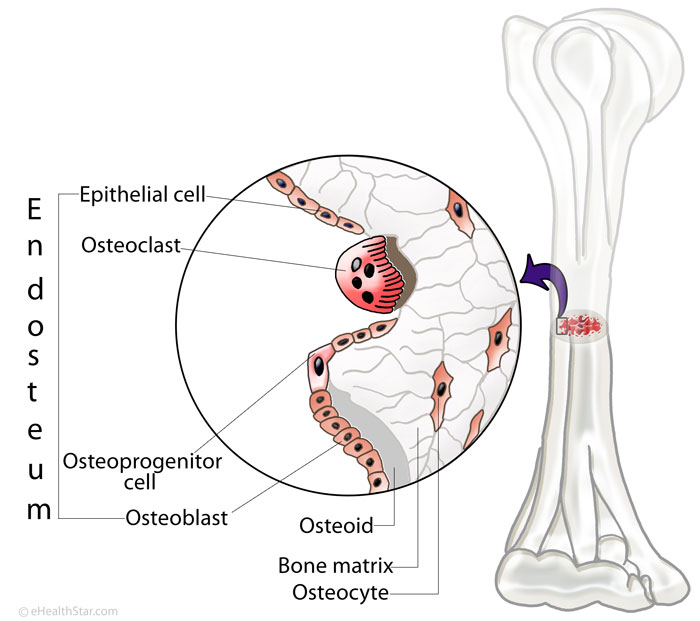Endosteum Definition
Endosteum is a thin layer of connective tissue that lines the inner surfaces of all bones (the cavities within the bone).
Function
- Appositional bone growth (in width)
- Here is a video that shows how endosteum contributes to the growth of the osteons in the cortical bone.
- Bone remodeling
- Endosteum stimulates bone resorption on the inner bone surfaces and periosteum stimulates the formation of the new bone on the outer bone surfaces — this way the diameter of the medullary canal and the bone as whole increases with age 11.
- Bone repair after a bone fracture (hematoma > endosteal proliferation > callus formation > consolidation > remodeling) 9
- References: 1,2,11
Endosteum Location
Endosteum is found on all internal surfaces of bones: the medullary cavity, the hollow spaces in the trabecular (spongy) bone, Haversian (osteonic) and Volkmann’s (perforating) canals in the cortical (compact) bone of the long bones, such as humerus and femur, flat bones, such as ribs 5 and pelvic bones 6, and sesamoid bones, such as patella 10. NOTE: The surface of the skull bones that faces the brain is not covered by endosteum, but periosteum, which is a part of dura mater. Endosteum covers the cavities within the skull bones, though.
Picture 1. Endosteum location
Endosteum covers all inner surfaces of the bone:
medullary cavity, cavities in the spongy bone and Volkmann’s and Haversian canals
Endosteum Composition, Blood Supply and Innervation
Endosteum contains:
- A single layer of epithelial cells, and osteoprogenitor cells or bone stem cells and cells that develop from them: osteoblasts (bone-forming cells) and osteoclasts (bone dissolving cells) 3
- Small amount of connective tissue fibers
- The endosteum cells and fibers, which form a type of connective tissue called loose connective tissue 8
- Blood vessels (perforating arteries) 7,11
- Autonomic nerve fibers, which run along the arteries and mainly regulate the tone of blood vessels 12,14
- Other references: 1,3
Picture 2. Endosteum structure
Difference Between Endosteum and Periosteum
| Characteristic | ENDOSTEUM | PERIOSTEUM |
| Location | Medullary canal, spongy bone, Volkmann’s and Haversian canals of all bones | Outer bone surfaces, except articular surfaces; not in sesamoid bones (patella) |
| Structure | A single cellular layer, loose connective tissue | Two layers: fibrous and cellular layer (cambium), dense irregular connective tissue |
| Thickness | ~10 micrometers (0.01 mm) 13 | 0.1-0-5 mm |
| Function | Bone growth, remodeling, repair | Bone growth, remodeling, repair, bone sensitivity, nourishment |
- References
- PubMed (Bone lining and hematopoiesis)
- Medscape (Description of bone healing)
- Inkling.com (Structure of bones)
- Virginia.edu (Bone formation)
- Wiley.com (Bone remodelling in human ribs)
- PubMed (Endosteal cells in human iliac bone)
- Orthobullets.com (Bone circulation)
- Etsu.edu (Skeletal system)
- General Principles of Orthopedics and Trauma, y. 2013, p.5 (Stages of fracture healing)
- PubMed Central (Aneurysmal bone cyst in patella)
- Asnjournals.org (Normal bone anatomy and physiology)
- Springer.com (Physiology of bone formation and remodeling)
- Nuclear Medicine Radiation Dosimetry: Advanced Theoretical Principles, y. 2010, p.512 (Endosteum thickness)
- Bone structure OERPUB




According to Netters, the endosteal layer is firmly and lavishly attached to the skull, followed by the periosteum. Your thoughts?
no information about innervation
Endosteum is innervated mainly by the sympathetic autonomic nerves that regulate the tonus of the blood vessels. These nerves run along the arteries. Periosteum also contains sensory nerve fibers but I’m not sure if endosteum does.
Good explanation! Thank you!
Sequence of endosteum periosteum cortex medulla from outer to inner
Madhur: periosteum, cortex, endosteum, medulla.